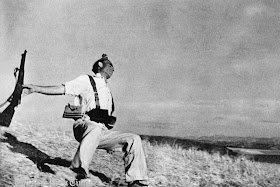

Ferguson argues that it matters more than ever that Capa has now been ‘proven’ to be 30 miles away from the front line of the bloody Spanish Civil War, because the viewer was being sold truth at the time and because in our media saturated times (a phrase I loathe), it’s so easy to fake photographs.
I’d argue that it’s always been easy to fake or alter photographs (see Frank Hurley’s fascinating and sophisticated first world war images) and that Capa’s exact whereabouts matters little, especially now. The photograph is not real life, nor is it a copy of real life.
The problem with my argument is that if it is played out to its logical conclusion, it doesn’t matter if photographs are faked or not (a different argument from whether they are ‘true’, it’s important to note). As I have not become, as far as I am aware, Piers Morgan’s apologist, I don’t exactly subscribe to this view. But it’s complex. The only thing that really outraged me about Morgan’s publication of the fake torture pictures in The Mirror was their blindingly obvious fakeness. The subsequent furore and Morgan’s swift demise only succeeded in shifting attention away from an illegal war and despicable war crimes, which were of course all too true.
The classic photojournalist’s image – shot for immediate publication in a news context – needs to be verifiable. Ideally. As far as I can tell from reading around, the caption and the context changed with the publication of Capa’s image first in Vu and then in Life. It was only in the latter publication that the photograph purported to be the moment of death. That the original caption stays with the photograph is essential to its future travels, the more so when it has or takes on the qualities of an ‘iconic’ image (another gargantuan debate in itself).
I remember the first time I saw a photograph by Simon Norfolk, an image from Bleed of a lake in Petkovici, Bosnia. My gaze was drawn across the crowded Photo London salon by the image; my interest and attention held by the caption, which detailed how hundreds of Bosniac men and boys had been executed nearby, and some of their bodies were believed to have been thrown into the lake. When, not long after, I discovered that his prints are widely collected, I remember wondering if his patrons would display the essential caption, too, and, further, would any museum? Of course not. So naturally its meaning might slip over time. And if it transpired that no bodies were in this lake, but actually in a lake thirty miles away, for example, would this detract from the power of this photograph? Or its truth? Not for me. Great images have long legacies and, to paraphrase Larkin, though their element is time, they are perhaps not suited to the long perspectives open at each instant of their lives.
In many ways the ultimate actor, always in character as a kind of cross between a Hollywood leading man and a war photographer, Endre Friedmann aka Robert Capa was telling a truth of war that wasn’t fake. In the way that Picasso’s Guernica has become a symbol for anti-fascism (despite the fact that the city of Guernica was far from being the most devastated during the war), Capa’s Falling Soldier could perhaps then simply represent the millions of young men who die fighting for a cause they believe in. People say Capa’s man looks heroic. What haunts me is that he is essentially dying alone, another fact that isn’t literally true.
-Max Houghton
See also El Periodico: Iconic Capa War Photo was staged ...

Geen opmerkingen:
Een reactie posten